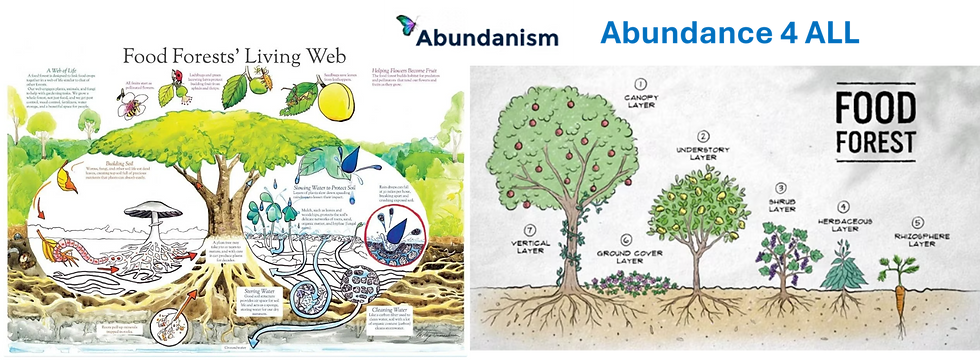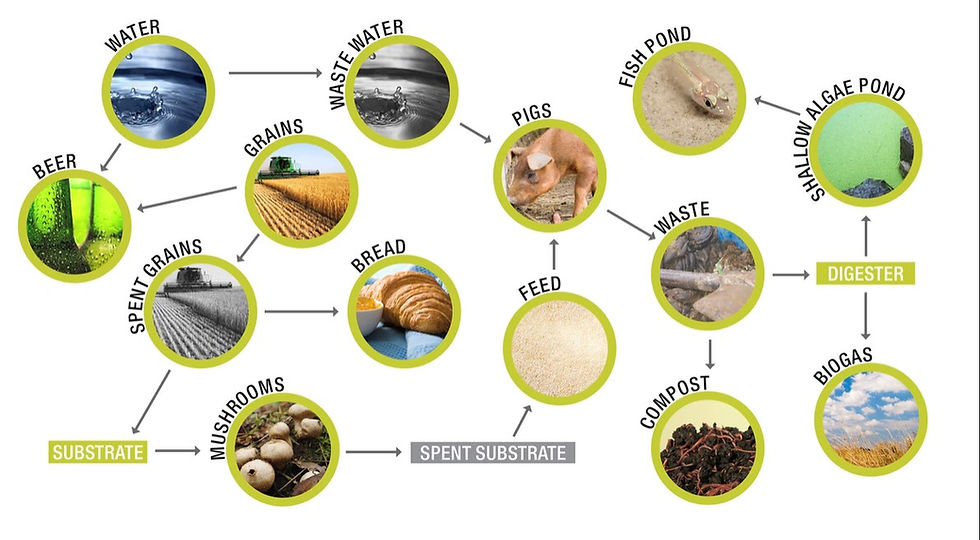Why Ecosystem Restoration Is So Important for Regenerative Business Models
- Desiree Driesenaar
- Dec 2, 2021
- 6 min read
We need abundant resources, resources, resources… but there is more to it

Picture credit: from the documentary Green Gold by John D. Liu. Used with permission.
My writing about the new, regenerative business models of our century interests a lot of people. However, few people realize that ecosystem restoration will always need to be part of these models.
We need to change our thinking from scarcity to abundance. This is important because it will create positive spirals instead of remaining stuck in the negative ones. We need innovation with the technologies nature gives us: (quantum) physics, biology, and green chemistry. We need abundant resources to survive on a finite planet.
Humility
But there is more to it: we need to face the fact that we, humans, are part of nature. We do not own it, it does not exist just to serve us. We now treat nature as a commodity. And that is a big part of the problem, a big part of the current crisis we are in.
We need to find our humility again. We need to restore the damage done in the past decades and start being earth stewards. The good news is that there are already working examples of a regenerative economy. And the rewards are worth fighting for: multiple value streams. Not just money, but also other important values like clean air, healthy drinking water, and social justice.
These value streams will serve all species. We will find the positive spiral of nature when we restore ecosystems and learn together how to find local ways how to live within these ecosystems without destroying them.
Degraded Environment
Let’s start with a fact that is denied by no one: our environment has been degraded. The United Nations International Strategy for Disaster Reduction defines environmental degradation as “the reduction of the capacity of the environment to meet social and ecological objectives, and needs.”
Perhaps people think this is just a fact in desertified areas in the (sub)tropics, but I’m afraid it’s all around us. In Europe and the USA, you might argue that social objectives are met by wealth and GDP figures, although some rightly say that social justice is not measured here.
But whatever way you look at it, ecological needs are definitely suffering if you read the reports about biodiversity loss and insects dying.

(GRAPHIC) G. Grullón; (DATA) M. Sorg et al., 2013-Entomologischer Verein Krefeld, Germany. The context can be found in this article in Science Magazine.
Good news: we can do better!
Many groups argue that the Anthropocene is the cause of this. We live in an age dominated by human presence. We, humans, have a significant impact on the earth’s geology and ecosystems. Mostly, this is framed as bad news, but you can also argue it’s good news.
Humans have a very bad impact now, yes. But that also means we can do better, much better! And it’s up to us to explore why, how, and what.
Abundant resources
If we want business models for a regenerative economy, we need abundant resources. We need to change the way we think about materials. We need a different perspective on technology. A biomimicry perspective.
Ethos is important in this shift. What kind of humans do we want to be? Is maximizing profit giving our lives purpose? Or do we want to create optimum value for all?
Well, whatever philosophy you believe in, ecosystem restoration is always a great way to start. Whenever we create abundance, we create options on how to develop our regenerative economies further.
Boosting nature
Well, how does it work, ecosystem restoration? In short, many techniques are combined to find the positive cycle of nature again. Normally, it would take ages to restore degraded land, now we can help nature find its balance again in a shorter period of time.
Humans boost, nature does the rest. Ecosystem restoration always involves living soil. The Food and Agriculture Organisation of the United Nations (FAO) says that a quarter of our planet’s biodiversity is found in the soil.
To enhance soil biodiversity we need to feed the soil with organic matter and stimulate micro-organisms and fungi. Of course, we also need to repair the water cycles and plant diverse crops in many layers.
Living with Abundance
As soon as nature picks up its positive spiral again, abundance will be the result. And when that happens, we need to make our living in such a way that the chains will not be broken again.
No more chemical fertilizers, because it kills soil life and flushes too much nitrogen into our water cycles. No more big tractors, because it creates compaction of the soil. All these wonderful creatures underground are suffocated to death underneath the huge tractor wheels.
But don’t worry that I mention a lot of ‘no more’s’. There are many things you CAN do. And in its positive spiral, nature provides us with great yields. Better than many yields achieved with ‘normal’ agriculture.
Indigenous cultures and permaculture
The techniques used to boost nature come from different sources. First of all, there is a lot of old wisdom involved, derived from indigenous cultures. They really knew how to live with the land, locally using all they had available.
We can still learn a lot from their heritage. Then there are permaculture design techniques. Bill Mollison and David Holmgren, the founding fathers of permaculture design, explain it in a clear way in this short video.
“A sustainable system is any system that in its lifetime can produce more energy than it takes to establish and maintain it.” Bill Mollison.
And of course, there are others. Around the time permaculture was developed, in the 1970s, the book ‘The One Straw Revolution’ was written by Masanobu Fukuoka (1913–2008) in Japan.
Biodynamic farming is older, based on the work of Rudolf Steiner (1861–1925). And agroecology professor Pablo Tittonell has a great vision on how to use modern technology without disturbing the soil.
I know that some of the people involved in these movements think their own way is the best and only way. However, I believe in biodiversity and in diverse solutions depending on local situations and cultures. So please, let’s just start restoring ecosystems in many ways. Nature is our teacher!
Large scale restoration
Luckily, examples of restored ecosystems and the results in wealth, health and happiness for people around these ecosystems, are growing. One famous example that always amazes me, is the Loess Plateau in China.
An area the size of a whole country (the size of my country, The Netherlands) has been restored. Think about it. Such a large scale in less than 15 years! Part of the area looked like this in 1995.

Picture credit: Green Gold, a documentary by John D. Liu.
If you compare this with the picture at the top of this article, made in 2009, the result is astonishing!
A sacred mountain in India
Another example is a beautiful project in India: reforestation of the sacred mountain by John Button’s permaculture team. It started in 1989, and in 2018 Arunachala was a forested mountain again.
One of the key success factors has been the motivation of the local volunteers. It was common to see Arunachala ablaze because farmers were protecting their grass using fire and goats against shrubs. Arunachala was a fire mountain. But it changed.
Please read the story in the link and you will be amazed. Maybe this story can be an inspiration for the people in Brazil and the other Amazon countries?
“After less than two years, when a fire broke out amongst our plantings, local villagers spontaneously extinguished the fire. They knew the plants would be more value to them than rocks and grass.” John Button.
Food forests in Europe
Well, how about restoring ecosystems in the western world, where insects are dying, birds are starving and the rivers are polluted with chemical pesticides and fertilizers?
I see a heartwarming trend of food forests on the rise and I applaud it. In my country food forests are being planted as buffer zones between nature and farming.
This is a good inspirational step, a forebode to the time when nature-inclusive farming will be mainstream. When people realize that regenerative agriculture can feed the world and has better business models using all benefits of ecological intensification than current farming practices.
Food forests are also being planted in industrial areas. They can teach the employees of the residing companies about innovation and health provided by nature. They can promote the benefits of all ecosystems’ services (WWF- Living Planet Report 2016). Although I’d rather speak of ecosystem functions. They will serve humans ánd other species.
Additionally, food forests are being planted close to communities in order to teach people natural gardening techniques and provide social cohesion. And finally, food forests are being planted near schools where children will be inspired to build a good future for all species of our planet.
“Food forests are hot and happening and I love it!”
Please, get your hands into the soil, too. It’s so much fun to learn and experiment on how to restore ecosystems. I guarantee it will make you feel better and give you loads of new, caring friends. It certainly changed my life for the better…
This article has first been published on Medium.




Comments